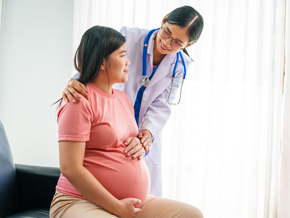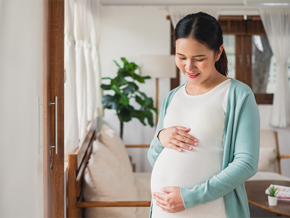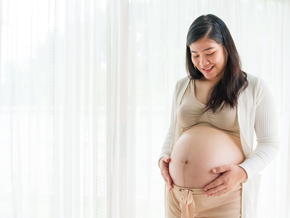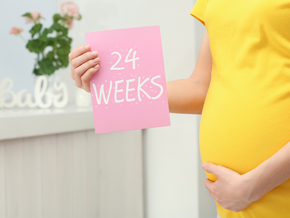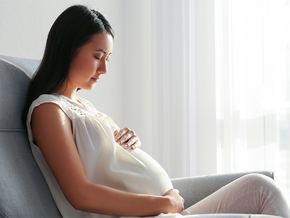
You stand up and feel a sudden, sharp twinge in your lower belly that vanishes as quickly as it came. Don't worry—that's likely your round ligaments stretching to support your growing uterus—a common sign at 15 weeks pregnant.
This week, your little one is also busy developing new senses as your body works to make space. Here’s what these new changes mean for you.
How Your Baby Is Growing at Week 15
Your little one is now approximately the size of an apple, measuring around 10 centimeters in length.
The World Health Organization (WHO) growth charts show the average 15-week baby weighs about 114 grams (4 ounces), with a range of 89 to 144 grams.
Proportional growth
Your baby, at 15 weeks pregnant, is starting to look more like a tiny human. Their legs are continuing to grow longer than their arms, and their whole body is becoming more proportionate. They’re constantly moving, twisting, and turning in the amniotic fluid, even if you can’t feel it just yet.
Developing senses and skills
Around this time, the tiny bones in your baby’s ear are forming, laying the groundwork for their sense of hearing. They’re also constantly preparing for life outside the womb by inhaling and swallowing amniotic fluid. This is a good thing—it’s an essential process that helps their lungs develop and gives them their first taste of flavors from your diet.
A 2024 scientific review in the journal Annual Review of Nutrition explains that aromas from your diet transfer to the amniotic fluid, giving your baby a taste of the foods you eat. While scientists are still exploring the details of this amazing process, it's clear your baby’s senses are rapidly developing.
Finding out the gender
Although your baby's external genitalia have now formed, getting a clear view can still be tricky for the technician. You may still need to wait until your mid-pregnancy scan in a few weeks for a more definitive answer.
You may also hear myths that the shape of your bump can predict gender (read more on Week 20), but these aren’t reliable indicators. The most accurate way remains ultrasound imaging at your anatomy scan.
Your Changing Body: Bump, Aches, and Pains
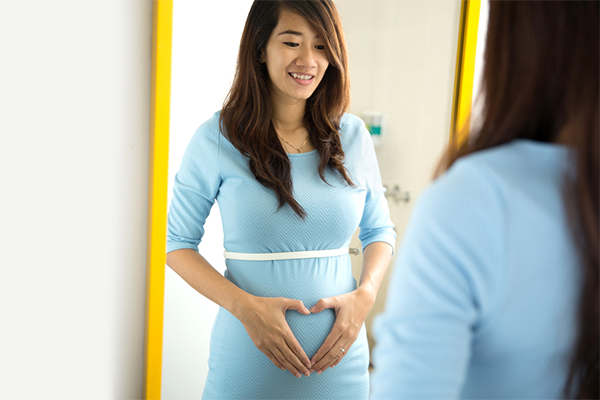
At 15 weeks pregnant, you’re in your second trimester, a time often marked by returning energy and a growing baby bump.
By now, you may be sporting a visible baby bump. If this is your first pregnancy, it might still be small, but it often appears sooner in subsequent pregnancies.
Sudden twinges (round ligament pain)
As your uterus expands, you may notice sudden twinges or a dull ache in your lower belly—classic signs of round ligament pain. In a 2023 scientific review discussing the various causes of abdominal pain in pregnancy, researchers describe round ligament pain as a classic, harmless symptom.
The study notes it often begins at the start of the second trimester and affects 10% to 30% of all pregnancies. While the sensation can be surprising, it's usually brief and caused by the ligaments supporting your uterus stretching. Contact your doctor about any severe or persistent pain to rule out other issues.
A constantly stuffy nose (pregnancy rhinitis)
If you've been feeling congested lately, you're not alone. A 2025 review in Current Otorhinolaryngology Reports found pregnancy rhinitis affects 20 to 30% of women, often starting in the second trimester as hormones like estrogen rise.
The study also found that saline sprays or rinses can help provide relief, and that symptoms typically resolve on their own after you give birth.
Discharge and spotting
You might experience an increase in vaginal discharge at 15 weeks pregnant. This helps protect the birth canal from infection. However, if the discharge has a strong odor, is greenish or yellowish, or is accompanied by itching or redness, contact your healthcare provider.
You should also report it to your doctor when you’re 15 weeks pregnant and spotting. These warning signs may suggest you're at risk of miscarriage.
• Heavy, period-like bleeding, which may include passing grayish tissue or blood clots
• Severe cramps and abdominal pain, often worse than typical menstrual cramps
• A low back ache that can range from mild to severe
• A sudden decrease in pregnancy symptoms, like nausea or breast tenderness
Nutrition for You and Your Baby
Eating iron-rich foods like leafy greens and omega-3s from fish like salmon supports your baby’s brain and your own health.
Focus on a balanced diet rich in these key nutrients to support you and your baby.
- Eat foods rich in iron like lean meat, lentils, and spinach to support your growing blood supply.
- Pair them with a source of vitamin C, like oranges or bell peppers, to help your body absorb the iron.
- Add calcium from dairy, fortified milks, or tofu to help build your baby’s developing bones and teeth.
- Don't forget omega-3 fatty acids from sources like salmon, walnuts, and chia seeds.
A 2022 super-review in Pharmacological Research found that omega-3s are proven to reduce your risk of serious conditions like preeclampsia and preterm delivery, while also boosting your baby's brain, vision, and immune system development.
Tips for a Healthy 15th Week
Feeling good during pregnancy involves taking care of yourself. Here are a few tips to help you through this week.
Find a comfortable sleeping position
Sleep gets easier now that early symptoms are fading, notes the Sleep Foundation. To make the most of it, focus on sleeping on your side, particularly the left side, as this improves blood flow to your baby. For extra comfort, try placing a pillow between your knees and under your belly.
Stay active
With your energy returning, now is a great time to get moving. The American College of Obstetricians and Gynecologists (ACOG) strongly recommends safe exercise to lower your risk of gestational diabetes, reduce the chance of a C-section, and lead to a faster postpartum recovery.
A 2022 review in BMC Sports Science, Medicine and Rehabilitation highlights that moderate-intensity activities, such as brisk walking, swimming, light strength training, and prenatal yoga, are all excellent choices. The key is to find something you enjoy and listen to your body. As always, get the green light from your doctor before starting any new routine.
Plan for your next scan
Your mid-pregnancy ultrasound (also known as the anatomy scan) usually happens between Week 18 and Week 20. During this detailed scan, the technician will examine your baby to make sure all their organs, limbs, and other body parts are developing correctly. It's also the scan where you can usually find out your baby's gender, if you choose.
At 15 weeks pregnant, you’re entering a stage of exciting changes—more energy for you, and rapid development for your baby. Your little one is already practicing vital skills, from tasting flavors in the amniotic fluid to preparing their senses for the world outside.
Are you enjoying being 15 weeks pregnant? Join the conversation and compare notes with other parents in the ParentTeam Moms and Dads Facebook group!
References
Alves, C., S. M. Jenkins, and A. Rapp. "Early Pregnancy Loss (Spontaneous Abortion)." In StatPearls. Treasure Island, FL: StatPearls Publishing, 2025. Last updated October 12, 2023. Accessed September 22, 2025. https://www.ncbi.nlm.nih.gov/books/NBK560521/
American College of Obstetricians and Gynecologists (ACOG). "Changes During Pregnancy." n.d. Accessed September 22, 2025. https://www.acog.org/womens-health/infographics/changes-during-pregnancy
American College of Obstetricians and Gynecologists (ACOG). "How Your Fetus Grows During Pregnancy." n.d. Accessed September 22, 2025. https://www.acog.org/womens-health/faqs/how-your-fetus-grows-during-pregnancy
American Pregnancy Association. "15 Weeks Pregnant." n.d. Accessed September 22, 2025. https://americanpregnancy.org/healthy-pregnancy/week-by-week/15-weeks-pregnant/
Cilar Budler, L., and M. Budler. "Physical Activity during Pregnancy: A Systematic Review for the Assessment of Current Evidence with Future Recommendations." BMC Sports Science, Medicine and Rehabilitation 14, no. 133 (2022). https://doi.org/10.1186/s13102-022-00524-z
Cleveland Clinic. "Pregnancy: Second Trimester." n.d. Accessed September 22, 2025. https://my.clevelandclinic.org/health/articles/16092-pregnancy-second-trimester
Eunice Kennedy Shriver National Institute of Child Health and Human Development (NICHD). "Pregnancy." n.d. Accessed September 22, 2025. https://www.nichd.nih.gov/health/topics/factsheets/pregnancy
Fielder, Stella P., Lucy K. Smith, Lisa Starrs, Carolyn Chiswick, Jemma Johns, James Goadsby, et al. "Understanding Care-Seeking and Subsequent Pregnancy Loss in the Second Trimester of Pregnancy − A Multicentre Audit." European Journal of Obstetrics & Gynecology and Reproductive Biology 305 (2025): 11-16. https://doi.org/10.1016/j.ejogrb.2024.11.018
Mayo Clinic. "2nd Trimester Pregnancy: What to Expect." February 7, 2025. Accessed September 22, 2025. https://www.mayoclinic.org/healthy-lifestyle/pregnancy-week-by-week/in-depth/pregnancy/art-20047732
Mayo Clinic. "Fetal Development: The 2nd Trimester." n.d. Accessed September 22, 2025. https://www.mayoclinic.org/healthy-lifestyle/pregnancy-week-by-week/in-depth/fetal-development/art-20046151
MedlinePlus. "Fetal Development." Last reviewed August 23, 2023. Accessed September 22, 2025. https://medlineplus.gov/ency/article/002398.htm
Silver, Natalie. "15 Weeks Pregnant: Symptoms, Tips, and More." Medically reviewed by Debra Rose Wilson. Healthline. October 23, 2017. Accessed September 22, 2025. https://www.healthline.com/health/pregnancy/15-weeks-pregnant











